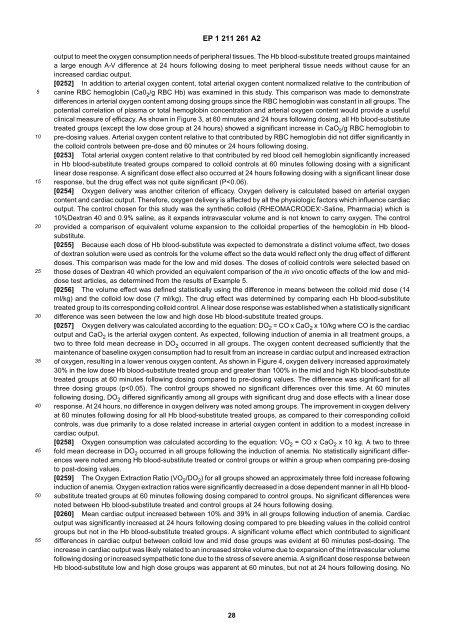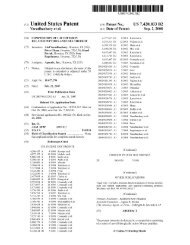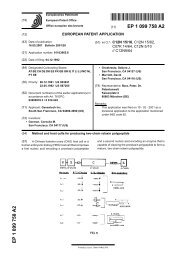<strong>EP</strong> 1 <strong>211</strong> <strong>261</strong> <strong>A2</strong>510152025303540455055output to meet the oxygen consumption needs of peripheral tissues. The Hb blood-substitute treated groups maintaineda large enough A-V difference at 24 hours following dosing to meet peripheral tissue needs without cause for anincreased cardiac output.[0252] In addition to arterial oxygen content, total arterial oxygen content normalized relative to the contribution ofcanine RBC hemoglobin (Ca0 2 /g RBC Hb) was examined in this study. This comparison was made to demonstratedifferences in arterial oxygen content among dosing groups since the RBC hemoglobin was constant in all groups. Thepotential correlation of plasma or total hemoglobin concentration and arterial oxygen content would provide a usefulclinical measure of efficacy. As shown in Figure 3, at 60 minutes and 24 hours following dosing, all Hb blood-substitutetreated groups (except the low dose group at 24 hours) showed a significant increase in CaO 2 /g RBC hemoglobin topre-dosing values. Arterial oxygen content relative to that contributed by RBC hemoglobin did not differ significantly inthe colloid controls between pre-dose and 60 minutes or 24 hours following dosing.[0253] Total arterial oxygen content relative to that contributed by red blood cell hemoglobin significantly increasedin Hb blood-substitute treated groups compared to colloid controls at 60 minutes following dosing with a significantlinear dose response. A significant dose effect also occurred at 24 hours following dosing with a significant linear doseresponse, but the drug effect was not quite significant (P
<strong>EP</strong> 1 <strong>211</strong> <strong>261</strong> <strong>A2</strong>510152025303540455055difference in cardiac output between Hb blood-substitute treated and colloid control groups was seen at 60 minutes or24 hours following dosing.[0<strong>261</strong>] Pulmonary artery wedge pressure (PAWP) did not change significantly during the induction of anemia. PAWPdecreased significantly in the low dose colloid group and remained unchanged in the mid dose colloid group 60 minutesfollowing dosing compared to pre dosing values. The PAWP in the mid and high dose Hb blood-substitute treatedgroups increased significantly in a linear dose response compared to pre-dosing values at 60 minutes following dosing.The increased PAWP reflected a dose dependent increase in intravascular volume at 60 minutes following dosing. Nosignificant drug effect was detected between Hb blood-substitute treated and control groups at 60 minutes or 24 hoursfollowing dosing. A significant volume effect was detected in the colloid control groups at 60 minutes following dosing.[0262] Systolic, diastolic and mean arterial blood pressure decreased significantly in all groups following inductionof anemia, then increased significantly immediately following dosing. The decrease in systolic arterial blood pressureafter the induction of anemia was likely related to a decrease in peripheral vascular resistance due to decreased bloodviscosity, a consequence of anemia. At 60 minutes following dosing, the systolic, diastolic, and mean arterial bloodpressures of both colloid control groups did not differ significantly from pre-dosing values. The systolic, diastolic, andmean pressures of the low dose colloid control increased significantly compared to pre-dosing values at 24 hoursfollowing dosing. In contrast, the increase in systolic, diastolic, and mean pressures was statistically significant in allHb blood-substitute treated groups at 60 minutes and 24 hours following dosing compared to pre-dosing values. Thesystolic, diastolic and mean blood pressures of Hb blood-substitute treated groups were significantly higher than correspondingcolloid control groups at 60 minutes following dosing, but not at 24 hours.[0263] Significant increases in systolic, diastolic and mean pulmonary arterial pressures were observed in the midand high dose Hb blood-substitute treated groups 60 minutes post dosing compared to pre dosing values. The increasespersisted at 24 hours post-dosing in the mid Hb blood-substitute treated group for pulmonary diastolic arterial pressure.Additionally the low-dose colloid group showed a statistically significant increase at 24 hours post-dosing comparedto pre-dosing values for mean pulmonary artery pressure. This increase was considered clinically significant. Theincreases in systemic arterial systolic and diastolic blood pressure 60 minutes following dosing of Hb blood-substitute,compared to pre-dosing values, were a direct drug effect of the Hb blood-substitute. The diastolic pressure remainedunchanged in the colloid control groups which was probably a result of a decreased peripheral vascular resistance.[0264] No significant differences were found between Hb blood-substitute treated and control groups for pulmonarysystolic arterial pressure at either 60 minutes or 24 hours post-dose. In contrast, pulmonary diastolic and mean arterialpressures were significantly different with regard to volume, drug, and dose effects at 60 minutes post dosing, but notat 24 hours.[0265] Total hemoglobin decreased approximately four times or greater with bleeding. Hb blood-substitute treatedgroups showed a dose dependent increase in total hemoglobin compared to corresponding colloid control groups at60 minutes and 24 hours following dosing.[0266] Plasma hemoglobin concentrations significantly increased in a dose dependent manner in Hb blood-substitutetreated groups compared to corresponding colloid control groups at 60 minutes and 24 hours following dosing. Theincreases in plasma and total hemoglobin concentrations following dosing in all Hb blood-substitute treated groups,as compared to their corresponding colloid controls, were attributable to the hemoglobin content of Hb blood-substitute.The dose dependent significant increase persisted for 24 hours, correlating with the persistent increase in arterialoxygen content.[0267] In summary, the response to treatment with the Hb blood-substitute was linear, i.e., at 60 minutes followingdosing, the higher the dose of Hb blood-substitute the greater the improvement in oxygen delivery and hemodynamicscompared to corresponding colloid controls. Sustained arterial oxygen content and normal clinical signs, while breathingroom air, support a beneficial biological effect of Hb blood-substitute lasting 24 hours in the 30 ml/kg and 45 ml/kg doseHb blood-substitute treated groups. The clearance of Hb blood-substitute likely accounts for the changes seen in oxygendelivery and hemodynamic effects at 24 hours following dosing. In conclusion, results from this study supportselection of a dose ranging from 30 to 45 ml/kg. Both of these dosing groups showed statistically significant differencesfrom corresponding colloid control groups in the parameters of efficacy and the dose response was linear.[0268] The clinical rationale of this dosing range is based on the fact that a severely anemic dog (e.g., hematocrit




